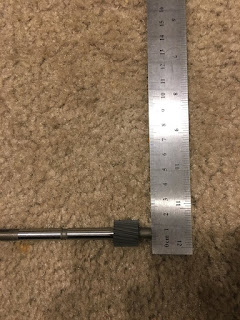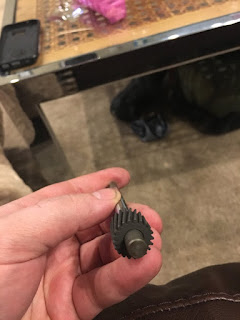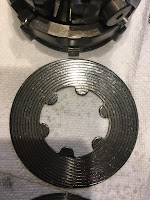Introduction
The Integra
and Civic chassis that Honda produced from the late eighties to the early 2000s
were set apart from average FWD cars because they could handle well out of the
box. With modification, they could handle even better.
One common
problem with FWD cars is understeer. Because the front wheels are doing
the accelerating, turning, and the majority of stopping, the tires tend to
"fall off" sooner than their RWD counterparts. To combat this,
FWD race car builders increase the chassis frequency, or "stiffness,"
of the rear of the car using sway bars or stiffer springs.
Photo of Chelsea the Civic Dog Legging by WindShadow Studios
In this
post, readers will see how EJ2 Track Rat was able to create a low-budget
solution for drivers looking to increase rear roll stiffness via use of a stiffer
sway bar in the rear of the car.
Background
Alex's
TrashTeg was driving fairly well. He was able to pass competition school
with NASA Northeast in it and he learned a fair amount about racecraft during
the course of the season. He was also having a ton of fun. However,
Alex was beginning to realize the limits of his budget-built car-- Partially
because his car had too much dive, squat, and roll under braking, acceleration,
and cornering, respectively.
Photo of TrashTeg Leaning by WindShadow Studios
When
TrashTeg was first built, it had the following setup:
- 205 Toyo RRs
- At a ride height of ~5.5-6 inches
- With a front spring rate of 650 pounds/inch,
- Rear spring rate of 750 pounds/inch,
- No front sway bar,
- A 25 mm GodSpeed (eBay) rear sway bar,
- And some Koni Sports he got for free from our friend
Anthony
Our goal was
to increase the roll stiffness of the car while still keeping the car
controllable at the limits with a healthy amount of rotation in corners.
We had two options: increase front and rear spring rate, with a stiffer rear
spring rate than front, or increase front spring rate and throw a big rear bar
on.
Since I only had a pair of 800 pound/inch springs in my garage, we figured we'd
throw the 800 pound/inch springs up front, and increase rear roll
stiffness without springs. The easiest way to do this is with a bigger sway bar, which
A-Spec Racing (ASR) makes. Their 32 mm hollow bars come in different
thicknesses and since they're hollow, they have the advantage of less weight
vs. their solid counterparts for the same amount of torsional resistance.
ASR Hollow Rear Sway Bar Kit
However, ASR
bars are not cheap at ~$500 for a full kit and Alex had already purchased a
$300 eBay sway bar kit. He wasn't about to spend $500 more for the ASR
product as a result. But, he and I were both interested in doing
something creative.
Getting Ready for some "Creativity" with a Welder
A while
back, I saw a thread on a forum where a Miata driver welded additional metal to his/her sway bar to increase torsional resistance, thereby increasing chassis
frequency at the respective end of the car.
Much debate
was had on this thread-- specifically whether one can weld to a sway bar and
expect it to work because sway bars go through a forging process that allows
them to become "spring steel." Spring steel is highly
malleable, but returns to the shape it was bent from fairly easily.
Welding to spring steel changes that property and increases brittleness.
Example of a Cracked Sway Bar (Not Ours)
Doing the Deed
Since we don't care about armchair engineers and we buy parts for our
destined-for-doom race cars on eBay, we decided it'd be worth a go to attempt
something similar. The new setup would have the following changes:
- Ride height lowered to 5" at pinch welds
- Front spring increased to 800 pounds per inch
- A "custom" xxx mm solid rear sway bar, courtesy of
the plumbing aisle at Home Depot
Sway Bar Diagram from ASR
Our Plan from EJ2 Track Rat
We laid out the eBay sway bar after purchasing the pipe from Home Depot and we started by measuring where our addition would be and how short we'd need it cut.
Laying Out the Sway Bar
Next, we cut our Home Depot pipe to length using a cut-off wheel. Ideally this would be done with a band saw, but with a pipe-vise it's easy to do with a $30 Harbor Freight cut-off wheel. The cut just isn't as clean.
Alex Cutting Home Depot Pipe to Length
Next we cut the pipe in half, lengthwise using our cut-off wheel and our old school bench vise from eBay.
Cutting the Home Depot Pipe in Half Length-Wise
To weld our cut-off half of the Home Depot pipe to our eBay sway bar, we would need to first clamp the OD of the Home Depot bar to the sway bar. After grinding the surface of the Home Depot pipe and the sway bar clean, we clamped the Home Depot bar to the sway bar using a set of Milwaukee vise grips.
Half of a Home Depot Pipe Clamped to an eBay Sway Bar
I ran a bead across a section to the left and right of the vise grip, then moved the vise grip down the length of the sway bar and repeated the process...the entire thing was done with flux wire.
Close-up of Beads Ran Next to Vise Grip
Picture 1 of Welded Sway
And Picture 2...
Finally, we sprayed the bar gloss black and mounted it onto the car. Once on the car, we checked to ensure clearance between our modified bar and the subframe brace was satisfactory.
The Bar Mounted to the Subframe
Checking Fit with Bar at Full Droop
Checking Fit with Bar at Full Compression
And after installing the rear bar, we installed my front springs and manually set ride height as we always do-- the LoBuk way.
Alex Setting Ride Height to Clock Bushings
Another View of Alex Setting Ride Height to Clock Bushings
Impressions
Alex tested TrashTeg at Watkins Glen in October of 2019 with NASA NE to see how the changes improved the car.
Alex Suiting up for a Race at The Glen
On Track, he noticed sharper turn-in due to the stiffer front springs, but the larger rear sway also allowed the car to have less mid-corner push. The new sway bar we created held up for a full weekend of abuse at one of the best and most demanding tracks in the Northeast.
After our racing shenanigans on Saturday we attended a NASA Northeast BBQ and had a good time. The car held up, the mods made it faster, and we had a great time.
Me, Alex, Jeremy, and Yuko at the NASA NE BBQ
Until next time, thanks for reading!






















































